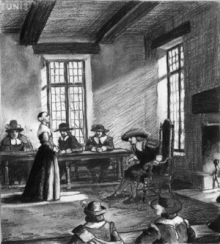Margaret Brent
| Margaret Brent | |
|---|---|

Monochrome painting of Margaret Brent speaking to the Maryland Assembly in colonial St. Mary's City.
By Edwin Tunis (c. 1934) |
|
| Signature | |
Margaret Brent (c. 1601 – c. 1671), an English immigrant to the Colony of Maryland, settling in its new capitol, St. Mary's City, Maryland, she was the first woman in the English North American colonies to appear before a court of the common law. She was a significant founding settler in the early histories of the colonies of Maryland and Virginia. Lord Calvert, Governor of the Maryland Colony, appointed her as the executrix of his estate in 1647, at a time of political turmoil and risk to the future of the settlement. She helped ensure soldiers were paid and given food to keep their loyalty to the colony, thereby very likely having saved the colony from violent mutiny, although her actions were taken negatively by the absentee colonial proprietor in England, Cecil Calvert, the second Lord Baltimore, and so ultimately she paid a great price for her efforts and was forced to leave the colony.
With Anne Hutchinson, Brent ranks among the most prominent female figures in early Colonial American history. Hailed as a feminist by some in modern times in advancing rights of women under the laws, her insistent advocacy of her legal prerogatives as an unmarried gentlewoman of property, while notable in its exceptional energy, was consistent on paper with English law. However, in the rough, male dominated world of the colonies, her stance for her rights and her independence was unusual in actual practice and it would have been fairly uncommon back in England in that period.
Born in Gloucestershire, England, Margaret Brent and her siblings were all adults when they emigrated from England. She was one of six daughters (of a total of thirteen children) of the Lord of Admington and Lark Stoke, Richard Brent, and his wife Elizabeth Reed (daughter of Edward Reed, Lord of Tusburie and Witten). Although Richard Brent served as the local sheriff, and the family was at least nominally part of the Church of England, their religion and political loyalty became suspect when one daughter (Catherine) proclaimed her return to the Catholic church and emigrated to Belgium. Under the religious name Christina, she ultimately became abbess of the English convent of Our Lady of Consolation in Cambrai), and was joined by two more sisters during the drawn out religious conflicts which culminated in the English Civil War.
...
Wikipedia
